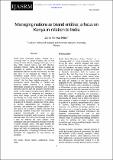| dc.description.abstract | World Book Dictionary defines “Nation’ as a
‘sovereign state’ or ‘group of people, race or tribe
having the same descent, language and origin.’ As of
May 2008, United Nations had 192 Members
excluding Vatican. Today, all these countries are
struggling to position themselves as favorable
destinations both for tourists and investors. For that
they have to be packaged as ‘brands’ in the
competitive global market arena. Although the
concept of branding has existed since the early 18th
century1
, this has been majorly employed in the
commercial world. According to Pickton and
Broderick (2001) branding is a strategy to
differentiate products and companies and to build
economic value for both the consumer and the brand
owner. In this context, branding can be defined as a
marketing process of designing and executing a
name, term, design, symbol, or any other features
that identify the country and its offers from those of
other countries. A nation as a brand is a combination
of quality of its products, attractiveness of its culture,
its tourism, opportunities for investment, its
economic, and political and foreign policies. It is
also said to be a country’s identity that has been
proactively distilled, interpreted, internalized and
projected internationally in order to gain
international recognition and to construct a favorable
national image. A country brand strategy therefore is
a plan for defining the most realistic, most
competitive and most compelling strategic vision for
a country (Akotia, 2010). This paper reviews the
various approaches employed by the two nations –
Kenya and India in positioning themselves in the
global perspective. A typology of the two brands is
developed and suggestions on way forward are
presented | en_US |

